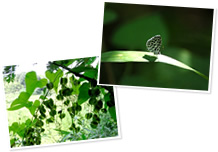Toiro Bussiness Oct."The Future of Yumeshima"
Toiro Business October Issue Preface "The Future of Yumeshima"
The preface by Chairman Natsuhara published in the October issue of Toiro Business is reprinted here with permission from Nature Research Institute Co., Ltd. (The Senshu Ikeda Banking Group).
---
The World Expo will be held in Yumeshima, Osaka in 2025. The theme of the 1970 Expo was "Progress and Harmony of Mankind." As a junior high school student, I joined a long line and saw the moon rocks, and was impressed by the wonderfulness of science and technology. On the other hand, Taro Okamoto appealed for the dynamic and dignity of life with the "Tree of Life" made inside the Tower of the Sun. The idea will be inherited after the Expo. A basic plan was formulated to make the site of the venue a "cultural park surrounded by greenery," and 600,000 trees were planted. About 40 years after planting, nature is steadily recovering, with goshawks nesting. Since 2000, in order to increase biodiversity, we have adopted a management method called "artificial gap" that cuts overgrown trees to create vacant lots and has continued monitoring.
At the 2005 World Exposition, Aichi, the nesting of goshawks was confirmed at the planned venue. The venue plan was significantly revised to protect the precious nature. Not only was the satoyama protected, but the venue was left with undulations of the terrain and a pond without land modification due to construction. During the session, wisdom for the conservation of the natural environment was utilized, such as the use of renewable energy and the use of wall greening "Biolang". These efforts led to the 2010 Convention on Biological Diversity COP10 and the 2014 ESD UNESCO Conference in Aichi.
The 2025 Expo will be held at a landfill site, unlike previous expositions. However, it is not known that this is a treasure trove of nature. Thousands of waterfowl, eagle and hawks, including hundreds of common shelducks, fly to the transitional wetlands, and the endangered little tern breeds. The growth of extinct aquatic plants, Ditch-grass, was also confirmed in Osaka. In the inner part of Osaka Bay, where Yumeshima is located, a tidal flat called Naniwa Lagoon originally spread, forming a rich fishing ground. Realize nature with abundant connections between land and sea. Although the tidal flats were lost due to reclamation, the migration route of waterfowl did not change, and they visited again when artificial tidal flats appeared. Can we return a part of the dwelling that humans have robbed?
Osaka has been created by people and the sea. The algae salt was burned, the seafood was harvested, and the merchant ships went. Osaka covered with concrete is only a temporary figure. As a way of society after the corona, green recovery, which is an economic policy that emphasizes the environment, is required. It is wonderful that Yumeshima will become a smart city using the latest technology, but the richness of the sea should not be left behind.
How can we convey the richness of the sea to our children? In Hannan City, elementary school students are working on the regeneration of eelgrass beds. The sea forest (eelgrass and seaweed) becomes a cradle for fish and is useful for global warming countermeasures. Kombu is cultivated in Tokyo Bay. A rich seaweed bed was formed on the sloped revetment at Kansai Airport, and scorpion fish and rockfish settled there. Chiromantes haematochea live in the forest of Nanko Bird Sanctuary (Nanko Bird Sanctuary), and sea fireflies shine on the coast of Sennan. "Designing future society for our lives" to be implemented on Yumeshima should be a society that brings about the realization that the earth is not only for people, but also nurtures many lives.
(Kosha) Chairman of Osaka Nature Conservation Association, Professor Emeritus of Nagoya University Yoshihiro Natsuhara
(Biography) Born in Shiga prefecture in 1956.
Graduated from Kyoto University Graduate School of Agriculture with a doctoral degree. Ph.D. (Agriculture).
After working as a researcher at Osaka Prefecture University of Environmental Sciences, an assistant professor at Osaka Prefecture University, and a specially appointed professor at Kyoto University, he was a professor at the Graduate School of Environmental Studies, Nagoya University from 2010 to 2021. His specialty is conservation ecology.
Major books: "Global Environment and Conservation Biology" (Iwanami Shoten), "Lively Rice Fields" (Kyoto Tsushinsha), "Forest of Life: Theory and Practice of Biologically Friendly Cities" (Kyoto University Press)
























